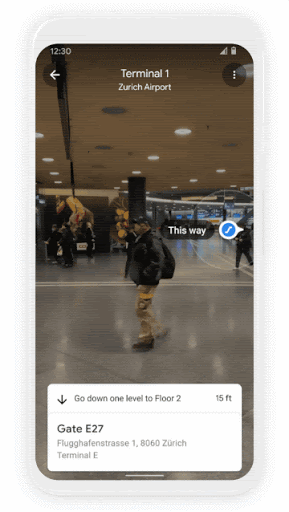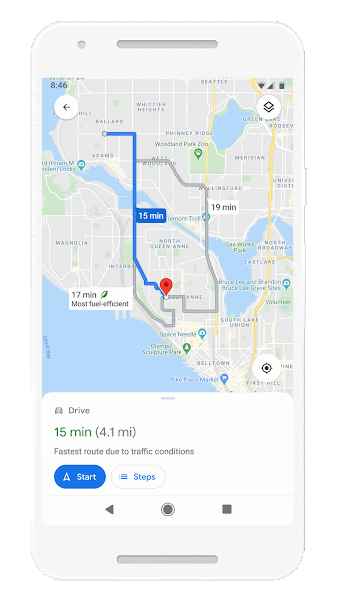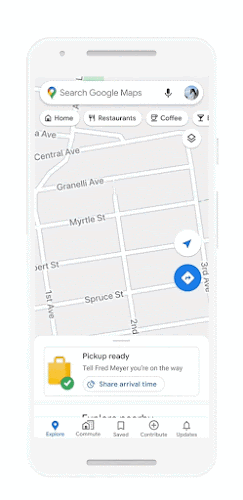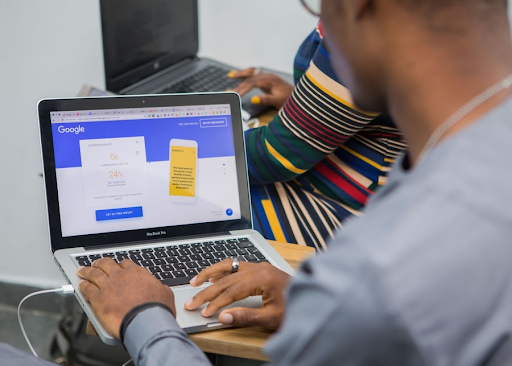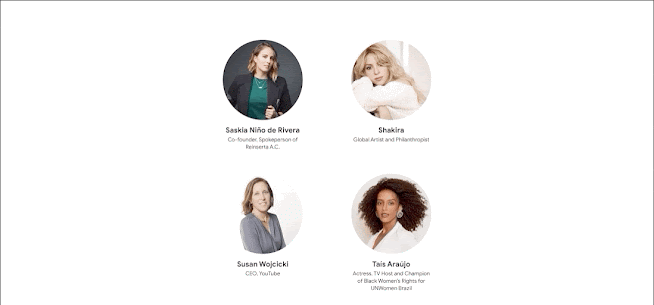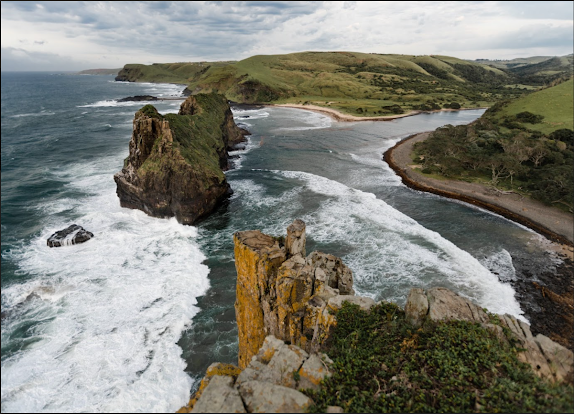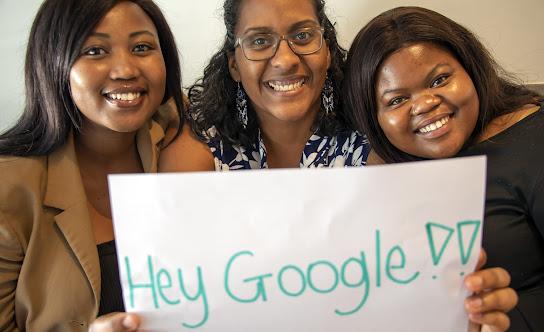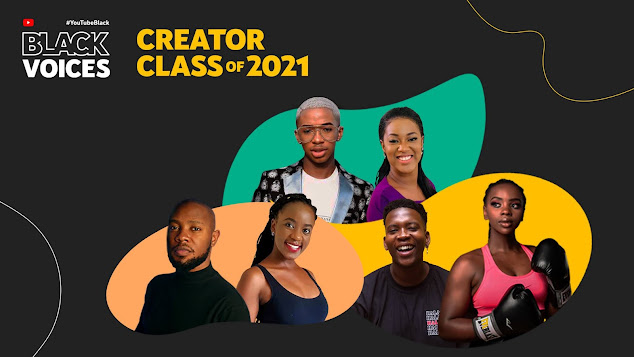Navigate indoors with Live View
We all know that awkward moment when you're walking in the opposite direction of where you want to go — Live View uses AR cues to avoid just that. Live View is powered by a technology called global localization, which uses AI to scan tens of billions of Street View images to understand your orientation. Thanks to new advancements that help us understand the precise altitude and placement of objects inside a building, we’re now able to bring Live View to some of the trickiest-to-navigate places indoors: airports, transit stations and malls.
If you’re catching a plane or train, Live View can help you find the nearest elevator and escalators, your gate, platform, baggage claim, check-in counters, ticket office, restrooms, ATMs and more. Arrows and accompanying directions will point you the right way. And if you need to pick something up from the mall, use Live View to see what floor a store is on and how to get there so you can get in and out in a snap. Indoor Live View is live now on Android and iOS in a number of malls in Chicago, Long Island, Los Angeles, Newark, San Francisco, San Jose, and Seattle. It starts rolling out in the coming months in select airports, malls, and transit stations in Tokyo and Zurich, with more cities on the way.
Plan ahead with more information about weather and air quality
With the new weather layer, you can quickly see current and forecasted temperature and weather conditions in an area — so you’ll never get caught in the rain without an umbrella. And the new air quality layer shows you how healthy (or unhealthy) the air is — information that’s especially helpful if you have allergies or are in a smoggy or fire-prone area. Data from partners like The Weather Company, AirNow.gov and the Central Pollution Board power these layers that start rolling out on Android and iOS in the coming months. The weather layer will be available globally and the air quality layer will launch in Australia, India, and the U.S., with more countries to come.
We all know that awkward moment when you're walking in the opposite direction of where you want to go — Live View uses AR cues to avoid just that. Live View is powered by a technology called global localization, which uses AI to scan tens of billions of Street View images to understand your orientation. Thanks to new advancements that help us understand the precise altitude and placement of objects inside a building, we’re now able to bring Live View to some of the trickiest-to-navigate places indoors: airports, transit stations and malls.
If you’re catching a plane or train, Live View can help you find the nearest elevator and escalators, your gate, platform, baggage claim, check-in counters, ticket office, restrooms, ATMs and more. Arrows and accompanying directions will point you the right way. And if you need to pick something up from the mall, use Live View to see what floor a store is on and how to get there so you can get in and out in a snap. Indoor Live View is live now on Android and iOS in a number of malls in Chicago, Long Island, Los Angeles, Newark, San Francisco, San Jose, and Seattle. It starts rolling out in the coming months in select airports, malls, and transit stations in Tokyo and Zurich, with more cities on the way.
Find your way inside airports, train stations, and malls with Indoor Live View
With the new weather layer, you can quickly see current and forecasted temperature and weather conditions in an area — so you’ll never get caught in the rain without an umbrella. And the new air quality layer shows you how healthy (or unhealthy) the air is — information that’s especially helpful if you have allergies or are in a smoggy or fire-prone area. Data from partners like The Weather Company, AirNow.gov and the Central Pollution Board power these layers that start rolling out on Android and iOS in the coming months. The weather layer will be available globally and the air quality layer will launch in Australia, India, and the U.S., with more countries to come.
See helpful air quality and weather information with new layers in Google Maps
With insights from the U.S. Department of Energy’s National Renewable Energy Lab, we’re building a new routing model that optimizes for lower fuel consumption based on factors like road incline and traffic congestion. This is all part of the commitment we made last September to help one billion people who use our products take action to reduce their environmental footprint. Soon, Google Maps will default to the route with the lowest carbon footprint when it has approximately the same ETA as the fastest route. In cases where the eco-friendly route could significantly increase your ETA, we’ll let you compare the relative CO2 impact between routes so you can choose. Always want the fastest route? That’s OK too — simply adjust your preferences in Settings. Eco-friendly routes launch in the U.S. on Android and iOS later this year, with a global expansion on the way.
More eco-friendly routes let you choose the route with the lowest carbon footprint
Quickly know if your vehicle is allowed in the area, choose an alternative mode of transportation, or take another route with low emission zone alerts
But we know that getting around sustainably goes beyond driving. So we’re making it easier to choose more sustainable options when you’re on the go. Soon you’ll get a comprehensive view of all routes and transportation modes available to your destination — you can compare how long it’ll take to get there by car, transit or bike without toggling between tabs. Using advanced machine learning models, Maps will automatically prioritize your preferred modes — and even boost modes that are popular in your city. For example, if you bike a lot, we’ll automatically show you more biking routes. And if you live in a city like New York, London, Tokyo, or Buenos Aires where taking the subway is popular, we’ll rank that mode higher. This rolls out globally in the coming months on Android and iOS.
This summer, we’re also teaming up with U.S. supermarket Fred Meyer, a division of The Kroger Co., on a pilot in select stores in Portland, Oregon to make grocery pickup easier. After you place an order for pickup on the store’s app, you can add it to Maps. We’ll send you a notification when it’s time to leave, and let you share your arrival time with the store. Your ETA is continuously updated, based on location and traffic. This helps the store prioritize your order so it’s ready as soon as you get there. Check in on the Google Maps app, and they’ll bring your order right out for a seamless, fast, no-contact pickup.
All of these updates are possible thanks to AI advancements that have transformed Google Maps into a map that can reflect the millions of changes made around the world every day — in the biggest cities andthe smallest towns. Whether you’re getting around, exploring an area, or knocking out errands, let Google Maps help you find your way.
Posted by Dane Glasgow, VP of Product, Google Maps
Save time with curbside grocery pickup on Maps
Delivery and curbside pickup have grown in popularity during the pandemic — they’re convenient and minimize contact. To make this process easier, we’re bringing helpful shopping information to stores’ Business Profiles on Maps and Search, like delivery providers, pickup and delivery windows, fees, and order minimums. We’re rolling this out on mobile Search starting with Instacart and Albertsons Cos. stores in the U.S., with plans to expand to Maps and other partners.====
Redéfinir la cartographie grâce à de nouvelles informations et à l’intelligence artificielle
Publié par Dane Glasgow, VP of Product, Google Maps
Il y a juste seize ans, la conception du guidage pour bon nombre d’entre nous se réduisait à conduire avec une main sur le volant, et un itinéraire imprimé dans l’autre. Quant à obtenir des informations de circulation en temps réel ou les horaires d’ouverture d’un restaurant sur notre chemin, n’en parlons même pas. Depuis, nous avons révolutionné le potentiel d’une simple carte routière, notamment grâce au machine learning. Cette année, ce sont plus de 100 améliorations basées sur l’intelligence artificielle que nous allons intégrer dans Google Maps, pour vous permettre d’accéder à des informations exactes et à jour, dès que vous en avez besoin. Pour vous donner une idée de la façon dont nous exploitons l’IA, voici un aperçu de certaines nouveautés Google Maps qui seront introduites cette année.
Avec Live View, laissez-vous guider à l’intérieur d’un bâtiment
Qui ne s’est jamais perdu à l’intérieur d’un bâtiment ? C’est précisément pour éviter ce genre d’embarras que Live View utilise la réalité augmentée. Live View repose sur une technologie que nous appelons localisation globale, qui a recours à l’IA pour analyser des milliards d’images Street View et ainsi comprendre votre orientation. Grâce à de nouvelles avancées qui nous aident à calculer l’altitude exacte et le placement des objets à l’intérieur d’un bâtiment, nous pouvons désormais proposer Live View dans les endroits où l’on se perd le plus souvent : les stations de transports en commun, les centres commerciaux et les aéroports.
Vous avez un avion ou un train à prendre ? Live View vous aide à localiser l’ascenseur ou l’escalier roulant le plus proche, ainsi que votre porte d’embarquement, votre quai, la zone de récupération des bagages, les comptoirs d’enregistrement, les guichets, les salles d’attente, les distributeurs de billets, etc. Il vous suffit de suivre les flèches et les indications de guidage. Vous avez un achat à faire dans un centre commercial ? Utilisez Live View pour localiser l’étage où se trouve la boutique et pour vous guider à bon port, vous faisant gagner ainsi un temps précieux. Indoor Live View est déjà disponible sous Android et iOS dans certains centres commerciaux aux États-Unis (Chicago, Long Island, Los Angeles, Newark, San Francisco, San Jose et Seattle). Dans les prochains mois, elle s’étendra à certains aéroports, centres commerciaux et stations de transports à Tokyo et Zurich. D’autres villes suivront.
Prévoyez vos sorties en tenant compte de la météo et de la qualité de l’air
Avec le nouveau calque Météo, vous pouvez consulter rapidement la météo et la température actuelles d’une zone, ainsi que les prévisions. En cas de risques de pluie, plus question d’oublier votre parapluie. Et grâce au nouveau calque Qualité de l’air, vous saurez désormais si l’air que vous respirez est sain (ou pas), ce qui vous sera particulièrement utile si vous souffrez d’allergies ou que vous vous trouvez dans une zone sensible à la pollution atmosphérique ou aux incendies. Ces calques sont alimentés par les données que nous transmettent nos partenaires tels que The Weather Company, AirNow.gov et le Central Pollution Control Board. Ils seront disponibles sous Android et iOS dans les prochains mois. Le calque Météo sera déployé dans le monde entier. Le calque Qualité de l’air, quant à lui, sera dans un premier temps introduit en Australie, aux États-Unis et en Inde, avant d’être étendu à d’autres pays.
Grâce aux données que nous fournit le laboratoire américain National Renewable Energy Lab, nous développons actuellement un nouveau modèle d’itinéraire qui permet d’optimiser la consommation de carburant en fonction de facteurs tels que le degré de pente d’une route ou les ralentissements dus aux embouteillages. Cette innovation s’inscrit dans le cadre des engagements que nous avons pris en septembre dernier pour permettre à un milliard de personnes qui utilisent nos produits, d’agir de manière concrète pour réduire leur empreinte carbone. Prochainement, Google Maps proposera donc par défaut l’itinéraire le moins émetteur de CO2 lorsque cet itinéraire donne sensiblement la même heure d’arrivée que l’itinéraire le plus rapide. Si l’itinéraire plus écologique risque d’augmenter le temps de trajet de façon notable, vous aurez la possibilité de comparer l’impact carbone relatif des deux itinéraires avant de faire votre choix. Et si vous souhaitez privilégier l’itinéraire le plus rapide en toutes circonstances, pas de problème : il vous suffit de définir vos préférences dans les paramètres. Les itinéraires plus écologiques commenceront à être proposés aux États-Unis dans le courant de l’année, avec à terme une couverture mondiale.
D’Amsterdam à Jakarta, de nombreuses villes dans le monde ont établi des zones à faibles émissions, qui restreignent l’accès à certains véhicules polluants (voitures fonctionnant au diesel, véhicules avec certaines couleurs de vignette Crit'Air...) pour maintenir la qualité de l’air. Pour soutenir ces initiatives, nous avons développé de nouvelles alertes qui vont permettre aux conducteurs de mieux comprendre le fonctionnement de ces zones régulées. Ils sauront ainsi rapidement si leur véhicule est autorisé dans une zone spécifique, et, en cas de besoin, pourront se replier sur un autre mode de transport ou un autre itinéraire. Les alertes Zones à faibles émissions seront disponibles dès le mois de juin, sous Android et iOS, en France, en Allemagne, aux Pays-Bas et au Royaume-Uni. D’autres pays suivront par la suite.
Toutefois, nous sommes bien conscients que les modes de déplacement ne se limitent pas à la conduite en voiture. C’est pourquoi nous lançons une nouvelle interface de guidage qui permet de choisir facilement un mode de transport plus écologique lorsque vous vous déplacez. Bientôt, vous bénéficierez d’une vue complète sur tous les itinéraires et modes de transport possibles pour vous rendre à destination. Vous pourrez comparer les durées de trajet en voiture, en transports en commun et à vélo sans avoir à jongler entre différents onglets. Grâce à ses modèles de machine learning avancés, Maps vous présentera en priorité vos modes de transport préférés, et pourra même mettre en avant les modes de transport les plus plébiscités dans votre ville. Par exemple, si vous êtes un cycliste convaincu, nous vous présenterons davantage d’itinéraires à vélo. Si vous vivez dans une ville comme Paris, New York, Londres, ou Buenos Aires, où les gens privilégient souvent le métro, nous donnerons plus de visibilité à ce mode de transport pour vous permettre d’accéder rapidement à l’itinéraire. Ce nouveau mode de fonctionnement sera déployé partout dans le monde dans les prochains mois, sous Android et iOS.
Toutes ces nouveautés n’auraient pas pu voir le jour sans les progrès techniques de l'IA, grâce auxquels une simple carte peut aujourd’hui refléter les millions de changements qui se produisent quotidiennement dans le monde, dans les grandes villes comme dans les plus petits villages. Aujourd’hui, Google Maps vous accompagne et vous guide dans tous vos déplacements, que vous soyez en voyage ou simplement en train de faire vos courses.
